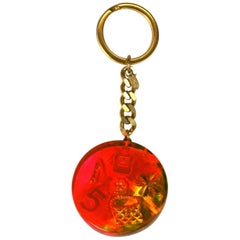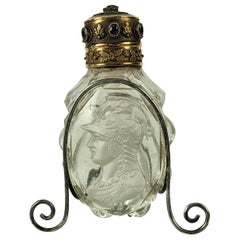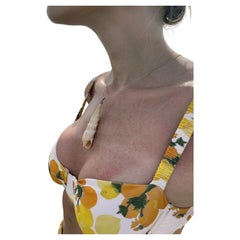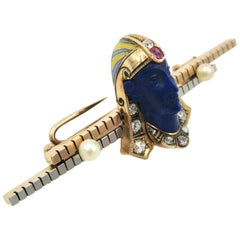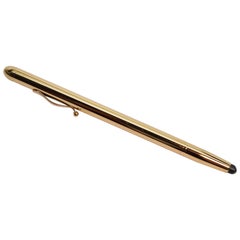New York - More Objets d'Art and Vertu
to
5
42
20
18
9
9
25
10
8
6
5
5
20
54
2
1
2
4
3
3
3
5
4
3
5
63
15
3
11
5
5
5
3
to
8
3
1
1
1
8
3
3
3
3
2
2
1
1
72
9
81
268
194
Item Ships From: New York
Chanel Hologram Fob Key Chain Spring 1997
By Chanel
Located in New York, NY
Authentic rare Chanel Hologram fob key chain or bag charm. A signature gilt curb chain suspends a round fob embedded with gilt motifs which display ...
Category
1990s French New York - More Objets d'Art and Vertu
Materials
Gold Plate, Gilt Metal
Amythest and Gold Sulphide Scent Bottle on Stand
Located in Riverdale, NY
Amythest and 18k Tri Color Gold Sulphide Cameo Scent Bottle on Stand, early 19th Century, possibly by Baccarat. A custom made period stand in sterling allows the bottle to be display...
Category
1820s French Georgian Antique New York - More Objets d'Art and Vertu
Materials
Amethyst, Gold, 18k Gold
Vintage Seashell Pendant
Located in New York, NY
VERY BREEZY presents: This pendant is crafted from a genuine auger seashell, and mounted with a gold-toned metal bail. It was sourced in Italy, and I love to imagine the adventures i...
Category
20th Century Italian New York - More Objets d'Art and Vertu
Rare Egyptian Revival Pharoah Brooch Lapis Diamond Ruby Pearl Enamel Art Deco
Located in New York, NY
This is a museum quality Belle Epoque - Art Deco Egyptian Revival masterpiece with a Lapis Lazuli Pharoah, adorned with Old Mine and Rose Cut Diamonds, Ruby, and Pearls and set in 14...
Category
1920s Unknown Art Deco Vintage New York - More Objets d'Art and Vertu
Materials
Ruby, Pearl, Lapis Lazuli, Diamond, Gold, Yellow Gold, Enamel, 14k Gold
Hattie Carnegie Whimsical "Insect" with Movable Wings Gilded Hardware Brooch
By Hattie Carnegie
Located in New York, NY
Hattie Carnegie wonderfully whimsical etched gilded gold vermeil hardware "Insect" brooch is accented with movable wings as if in flight whether being worn or just simply plac...
Category
1970s American Baroque Vintage New York - More Objets d'Art and Vertu
Louis Tamis & Sons Gold Stockbroker's Mechanical Pencil
By Louis Tamis
Located in Mount Kisco, NY
Louis Tamis & Sons fourteen karat 14k yellow gold mechanical stockbroker's pencil, circa 1955-1960. New York Maker, L T & Sons founded in 1909 became known as one of the top high-end...
Category
1950s American Vintage New York - More Objets d'Art and Vertu
Materials
Gold, 14k Gold, Yellow Gold
$1,080 Sale Price
20% Off
Franco-Russian Alexander III Commemorative Medallion, 1896
Located in St. Catharines, ON
In silvered bronze, a table medallion commemorating Nicholas and Alexandra’s visit to Paris to lay the first stone on the Alexander III bridge in 1896, w...
Category
1890s French Greek Revival Antique New York - More Objets d'Art and Vertu
Materials
Silver Plate, Bronze
Russian Civil War Commemorative Porcelain Cup and Saucer
Located in St. Catharines, ON
Painted between 1935 and 1946 by the Dimitrov Factory near Moscow, the rare porcelain cup and saucer commemorates the Russian Civil War of 1918-21. Of high quality with crisp detail and vivid color, the front of cup depicts a detailed scene of Red Army Cavalry on patrol while the saucer features exploding artillery shells on a burgundy background enhanced with gilt scrolls.
cup 2 1/8 in. ( 5.4 cm) high; 3 1/4 in. ( 8.2 cm) diam.
By Sergei Efremovich Sazonov (1870-1944), Dmitrovsk Porcelain Manufactory. Stamped with factory mark on base of cup and saucer in Russian: Dimitrovskaia for the factory, RSFSR for Russian Soviet Federated Socialist Republic, Verbilki town outside Moscow and NKMP:-Peoples Commissariat for Local Industry. Few examples of this service, which was produced in the former Gardner Factory, appear on the market.
Literature: For a plate by the Dmitrov Factory see Nina Lobanov-Rostovsky, Revolutionary Ceramics: Soviet Porcelain...
Category
Mid-20th Century Russian New York - More Objets d'Art and Vertu
Russian Silver Pencil Holder, Moscow, circa 1910
Located in St. Catharines, ON
From the Romanov era period of Tsar Nicholas II, this Russian revolution survivor from Moscow is designed as a smooth silver pencil holder engrave...
Category
1910s Russian Russian Empire Vintage New York - More Objets d'Art and Vertu
Materials
Silver
Thomas Wimbush Sterling Silver Leaded Glass Antique English Flask
Located in Mount Kisco, NY
Gentleman's Sterling Silver and Leaded Glass Antique English Flask. Six inches tall with removable bottom to form a cup.
Measures 6 x 3 x 1 inches. In ...
Category
Late 19th Century British Antique New York - More Objets d'Art and Vertu
Materials
Sterling Silver
18K Yellow Gold & Black Enamel Chihuahua Dog Brooch
Located in New York, NY
Adorable 18k yellow gold and black enamel excited Chihuahua dog brooch.
Chihuahua brooch is accented by two round sapphire gemstones for the eyes and a ...
Category
Late 20th Century Retro New York - More Objets d'Art and Vertu
Materials
Diamond, Blue Sapphire, 18k Gold, Yellow Gold, Enamel
Russian Silver Alexander II Tankard by Sazikov, St. Petersburg, 1859
By Pavel Sazikov
Located in St. Catharines, ON
From the Romanov era, period of Tsar Alexander II, the cover and sides of the trompe l'oeil silver tankard chased to simulate oak woodgrain, enhanced with horizontal polished silver gilt bands. The hinged cover has a crenelated edge surrounding a circle of dots like the rivets of an oak barrel. With curved handle and thumbpiece, with original gilded interior.
By Sazikov, with the Imperial Warrant, St. Petersburg, 1859, assaymaster Eduard Fedorovich Brandenburg, stamped with the maker's mark in full in Cyrillic.
5 ¼ in. (13.3 cm.) high including thumbpiece.
Literature: Beyond Fabergé: Imperial Russian Jewelry by Marie Betteley and David Schimmelpenninck van der Oye, Schiffer, 2020, page 309.
Supplier to the Imperial court and founded during the reign of Catherine the Great in the centre of Moscow, Sazikov was one of the earliest and finest silver firms in Russia. In the 1820s Sazikov introduced historicism in Russian silver by producing objects with historical motifs or imitating ancient styles. Decades before Fabergé, the firm excelled in the Style Russe...
Category
1850s Russian Russian Revival Antique New York - More Objets d'Art and Vertu
Materials
Silver
Timofey Katurkin Russian Watercolor of Laughing Woman
Located in St. Catharines, ON
Laughing Peasant Woman
Signed in Cyrillic T. Il’ich, l.r. and inscribed To Dear A. F.Sklarevski...
Watercolor
Image size: 7 x 6 in. (17.8 x 15.2 cm.)
Framed: 18 1/2 x 17 1/4 in. (47 ...
Category
Early 20th Century Russian Russian Empire New York - More Objets d'Art and Vertu
Alice Caviness Sterling Silver with Gold Overlay Moveable Butterfly Wings Brooch
By Alice Caviness
Located in New York, NY
Alice Caviness wonderfully detailed sterling silver with gold overlay butterfly brooch has all four wings moveable if desired. Filigree handwork and made in Germany. The upper...
Category
1970s German Artisan Vintage New York - More Objets d'Art and Vertu
Large Sterling Silver 'Maker's Mark' JFR Abalone-Center Floral Brooch
Located in New York, NY
Wonderfully detailed large brooch accented with a abalone center back-drop for the centerpiece featuring a 3-dimensional 'Vase with Fresh-Cut Florals'. Brooch is bordered with floral...
Category
1970s Unknown Artisan Vintage New York - More Objets d'Art and Vertu
Victorian-Era Etched Floral with Inlaid "Floral Lady" 3-Piece Silver Belt Buckle
Located in New York, NY
Magnificently detailed, this 3-piece Victorian-era etched Silver buckle of beautiful florals on all three pieces highlights the center buckle with inlaid "Floral Lady". All ...
Category
Early 1800s British Victorian Antique New York - More Objets d'Art and Vertu
Antique Russian Gold Diamond Sapphire Lorgnette
Located in New York, NY
Antique 14k gold Russian lorgnette, decorated with rose cut diamonds and a sapphire (stone is abraded). Comes in original box. Lorgnette measures 4.5" long with bale x 1 1/8" (when c...
Category
19th Century Russian Antique New York - More Objets d'Art and Vertu
Materials
Diamond, Sapphire, Gold
Magnificent Pair of Hand Carved Lavender Jadeite Masks
Located in Montreal, QC
Beautiful pair of Hand Carved Jadeite Masks. Light lavender and very light mint-green. Each has a diameter of 56 mm. Average thickness is 20 mm. Total weight of the pair is 226 grams...
Category
1990s Contemporary New York - More Objets d'Art and Vertu
Materials
Jade
Vintage Bulgari Mother of Pearl and Onyx Money Clip
By Bulgari
Located in New York, NY
A sophisticated mother of pearl and onyx money clip by Bulgari. Made in Italy, 18 karat gold.
Category
Late 20th Century Italian New York - More Objets d'Art and Vertu
Materials
Onyx, Yellow Gold
Mellerio Paris, a French Gold, Diamonds, Silver, and Smoky Quartz Carved Horse
By Mellerio dits Meller
Located in Queens, NY
Mellerio Paris, A French Gold, Diamonds, Silver-Gilt, Rock-Crystal, Jade, Mother-Of-Pearl and Smoky Quartz, Carved Horse Sculpture, Jeweled Mounted Object.
An extremely rare and unique, one of a kind French gold, diamonds, Silver-gilt, rock-crystal, jade, obsidian, mother-of-pearl, and smoky quartz carved jeweled sculpture "CHEVAUX DE LEGENDE", "A Legendary Horse" by Mellerio, Paris, circa 1991.
Sitting on black obsidian base, the solid rock-crystal slab is finely applied with a carved smoky -quartz and jade horse with a harness mounted in 18k gold, brilliant -cut diamonds, rubies, turquoise, and amethyst chains and pendants. The top columns adorned with 18k gold and brilliant cut diamond pendants, the bottom with gold and mother of pearl plaques. The obsidian base with a plaque engraved: CHEVAUX DE LEGENDE" / N° 05 / MELLERIO DITS MELLER / PARIS / 5003 D
The piece is in excellent condition and comes with a custom made wood case made for transport. It's very elegant and has French hallmarks throughout. A truly magnificent piece.
Measures 10.5" high x 8.5" wide x 4" deep
Founded in France in 1613 by the descendants of Italian immigrants from the Vigezzo Valley in the north of Italy, Mellerio is one of the oldest jewellery houses in Europe. The family business soon attracted the attention of the Royal Court and Marie Antoinette herself reportedly purchased a precious bracelet featuring 7 cameos surrounded by rubies in 1780. Later on, in the 19th century, Mellerio became the official supplier of the French Royal family and the Court of Netherland.
Mellerio creates many jewellery items, all set with rare gems such as peridots, amethysts, aquamarines, citrines and topaz, applying for a patent, the flexible stem, a very supple and light jewellery mechanism. Mellerio remains also well known for their spectacular series of Art Nouveau jewels, created at the beginning of the 20th century, as well as for the creation of trophies rewarding some of the greatest footfall and tennis players of history. In 1993, the jewellery house launched their first watch collection.
Today, Mellerio has stores in Paris, Japan and Hong Kong.
July 14, 1789: this date is known throughout the world as the beginning of the French Revolution. According to a ledger belonging to House of Mellerio, this was also the day that the jeweler sold a golden key to the Comte de Coutance for 10 livres. This ledger, as well as inventories dating as far back as 1768, are the jeweler’s oldest archives. These archives have continued to grow over the years, as the House, established on rue de la Paix in Paris, still lives on today, still in the hands of the same family from Craveggia, in the North of Italy.
The tumultuous history of the Mellerio family in France probably goes as far back as the Italian wars of the Renaissance, but the first official document proving their commercial activity in Paris dates back to 1613. This document is the famous royal warrant awarded by Marie de Medici to a number of Italian families established along the rue des Lombards, including the Mellerios, allowing them to sell “small jewelery items”, therefore granting them a small exception to the traditional monopoly enjoyed by Parisian jewelers. At that time, powerful corporations regulated the operations and customs of Parisian business, but thanks to this exceptional warrant, the Mellerios managed to escape the confines of this framework. Today, this wax-sealed document is kept at the city hall of Craveggia.
From 1613 to the Revolution, the Mellerios lived between France and Italy. The corporations tried many times to put an end to their trade privileges, but all in vain, as a dynasty of sovereigns renewed the warrant. Always marrying and often retiring in Craveggia, the Mellerios continued to maintain their jewelry business in Paris. At first, they did this without a shop. Wearing backpacks (wooden boxes divided into small compartments where jewels were kept), they would tour town fairs around Paris and royal castles.
This is how Jean-Baptiste Mellerio (1765-1850) is said to have sold a bracelet set with rubies and Antique cameos to Marie-Antoinette, which still exists today. Many elements seem to prove the veracity of this anecdote. The queen was particularly fond of cameos, which cover the entire background of her famous jewelry cabinet, and ruby was her favorite stone after diamond. The famous bracelet, reacquired a few years ago by the House of Mellerio, is indeed an 18th century jewel, set with antique cameos representing the profiles of Roman emperors. Two branches of the family were operating in Paris during this time, under the reign of Louis XVI: that of Jean-François (1746-1828), the paternal ancestor of the current Mellerios, and that of Jean-Baptiste (1765-1850).
The French Revolution forced them to return to Italy. However, both Jean-Baptiste and François Mellerio (1772-1843), who was the son of Jean-François, were eventually able to return to Paris after the founding of the Consulate. Jean-Baptiste opened a shop at the Iron Crown of rue Vivienne, and François opened his at the Palais des Tuileries, rue du Coq Saint-Honoré. His well-organized order books give an idea of his high-ranking clientele during the “Old Regime”, among which were the Comte and Comtesse Octave de Segur, the Marquise (later Duchess) de Tourzel, former governess of the royal children, and her daughter, the Comtesse de Bearn, the Craufurds -who organized the flight to Varennes, the Duc and Duchess de Gramont, the Comtesse de Boigne, and Madame de Souza, Talleyrand’s mistress.
We also see the names of the imperial family: Empress Josephine, the Queen of Holland, Princess Elisa, Caroline and Pauline. At that time, the House of Mellerio specialized, among other things, in the trade of antique cameos, a newly fashionable genre of jewel that captured the imagination of all the princesses and noble women of the time.
The years of the Restauration and July Monarchy were among the most glorious. The Bourbons were back on the throne, and the clientele of the House of Mellerio had regained its former wealth. Mellerio supplied Louis-Philippe, Duke of Orléans, as well as his mother, wife and sister, with sumptuous jewels, including a set of emeralds made piece by piece, while the Duke of Bourbon, last prince of the House of Condé, offered diamonds to his mistress, the scheming Baronne de Feucheres, and Monsieur de LaFayette also bought cameos for one of his granddaughters. For the first time, Mellerio ventured into the world of arts in 1815, when Carlotta Grisi, a famous dancer who created Giselle, as well as an actress named Rachel, bought jewels at the Mellerio store on rue de la Paix.
1848 marked a new turning point. France once again became a Republic. François Mellerio handed the company over to his son, Jean, and the latter decided to travel to Spain to build a new clientele. He later became one of the jewelers of the royal family, and met Eugénie de Montijo, who remained a faithful client when she became empress of the French people. The Imperial years were lavish. During the Second Empire, Paris was a pageant of crinoline dresses designed by Worth, while jewels by Mellerio, Worth’s neighbour on the rue de la Paix, adorned the noble women of the Tuileries court.
The Empress bought pearls. Mathilde Bonaparte...
Category
20th Century French New York - More Objets d'Art and Vertu
Materials
Amethyst, Diamond, Jade, Quartz, Rock Crystal, Ruby, Turquoise, Gold, Si...
Mellerio Paris, a French Gold, Diamond, Silver-Gilt, Rock-Crystal, & Lapis Horse
By Mellerio Paris
Located in Queens, NY
Mellerio Paris, A French Gold, Diamond, Silver-Gilt, Rock-Crystal, Obsidian & Lapis Horse
An extremely rare and unique, one of a kind French gold, diamonds, Silver-gilt rock-crystal, obsidian and lapis lazuli jeweled sculpture "Bucéphale, Chevaux de légende", "Bucephalus, A Legendary Horse" by Mellerio, Paris, circa 1998.
Sitting on black obsidian base, the solid rock crystal slab is finely applied with a lapis lazuli half-horse with harness mounted in 18k gold and brilliant cut diamonds, between two crystal and lapis lazuli columns adorned with gold and diamonds, insert with 7 ruby cabochons and 1 emerald cabochon, the obsidian base with a plaque engraved: CHEVAUX DE LEGENDE / MELLERIO DITS MELLER / PARIS / 5029 DIV
Bucephalus (c355-326 BC) is among the most famous horses in history, and it was said that this he could not be tamed. The young Alexander the Great, of course, tamed him – and went on to ride his beloved equine companion for many years and into many battles.
The piece is in excellent condition and comes with a custom made wood case made for transport. It's very elegant and has French hallmarks throughout. A truly magnificent piece.
Measures 10" high x 9" wide x 4" deep
Founded in France in 1613 by the descendants of Italian immigrants from the Vigezzo Valley in the north of Italy, Mellerio is one of the oldest jewellery houses in Europe. The family business soon attracted the attention of the Royal Court and Marie Antoinette herself reportedly purchased a precious bracelet featuring 7 cameos surrounded by rubies in 1780. Later on, in the 19th century, Mellerio became the official supplier of the French Royal family and the Court of Netherland.
Mellerio creates many jewellery items, all set with rare gems such as peridots, amethysts, aquamarines, citrines and topaz, applying for a patent, the flexible stem, a very supple and light jewellery mechanism. Mellerio remains also well known for their spectacular series of Art Nouveau jewels, created at the beginning of the 20th century, as well as for the creation of trophies rewarding some of the greatest footfall and tennis players of history. In 1993, the jewellery house launched their first watch collection.
Today, Mellerio has stores in Paris, Japan and Hong Kong.
July 14, 1789: this date is known throughout the world as the beginning of the French Revolution. According to a ledger belonging to House of Mellerio, this was also the day that the jeweler sold a golden key to the Comte de Coutance for 10 livres. This ledger, as well as inventories dating as far back as 1768, are the jeweler’s oldest archives. These archives have continued to grow over the years, as the House, established on rue de la Paix in Paris, still lives on today, still in the hands of the same family from Craveggia, in the North of Italy.
The tumultuous history of the Mellerio family in France probably goes as far back as the Italian wars of the Renaissance, but the first official document proving their commercial activity in Paris dates back to 1613. This document is the famous royal warrant awarded by Marie de Medici to a number of Italian families established along the rue des Lombards, including the Mellerios, allowing them to sell “small jewelery items”, therefore granting them a small exception to the traditional monopoly enjoyed by Parisian jewelers. At that time, powerful corporations regulated the operations and customs of Parisian business, but thanks to this exceptional warrant, the Mellerios managed to escape the confines of this framework. Today, this wax-sealed document is kept at the city hall of Craveggia.
From 1613 to the Revolution, the Mellerios lived between France and Italy. The corporations tried many times to put an end to their trade privileges, but all in vain, as a dynasty of sovereigns renewed the warrant. Always marrying and often retiring in Craveggia, the Mellerios continued to maintain their jewelry business in Paris. At first, they did this without a shop. Wearing backpacks (wooden boxes divided into small compartments where jewels were kept), they would tour town fairs around Paris and royal castles.
This is how Jean-Baptiste Mellerio (1765-1850) is said to have sold a bracelet set with rubies and Antique cameos to Marie-Antoinette, which still exists today. Many elements seem to prove the veracity of this anecdote. The queen was particularly fond of cameos, which cover the entire background of her famous jewelry cabinet, and ruby was her favorite stone after diamond. The famous bracelet, reacquired a few years ago by the House of Mellerio, is indeed an 18th century jewel, set with antique cameos representing the profiles of Roman emperors. Two branches of the family were operating in Paris during this time, under the reign of Louis XVI: that of Jean-François (1746-1828), the paternal ancestor of the current Mellerios, and that of Jean-Baptiste (1765-1850).
The French Revolution forced them to return to Italy. However, both Jean-Baptiste and François Mellerio (1772-1843), who was the son of Jean-François, were eventually able to return to Paris after the founding of the Consulate. Jean-Baptiste opened a shop at the Iron Crown of rue Vivienne, and François opened his at the Palais des Tuileries, rue du Coq Saint-Honoré. His well-organized order books give an idea of his high-ranking clientele during the “Old Regime”, among which were the Comte and Comtesse Octave de Segur, the Marquise (later Duchess) de Tourzel, former governess of the royal children, and her daughter, the Comtesse de Bearn, the Craufurds -who organized the flight to Varennes, the Duc and Duchess de Gramont, the Comtesse de Boigne, and Madame de Souza, Talleyrand’s mistress.
We also see the names of the imperial family: Empress Josephine, the Queen of Holland, Princess Elisa, Caroline and Pauline. At that time, the House of Mellerio specialized, among other things, in the trade of antique cameos, a newly fashionable genre of jewel that captured the imagination of all the princesses and noble women of the time.
The years of the Restauration and July Monarchy were among the most glorious. The Bourbons were back on the throne, and the clientele of the House of Mellerio had regained its former wealth. Mellerio supplied Louis-Philippe, Duke of Orléans, as well as his mother, wife and sister, with sumptuous jewels, including a set of emeralds made piece by piece, while the Duke of Bourbon, last prince of the House of Condé, offered diamonds to his mistress, the scheming Baronne de Feucheres, and Monsieur de LaFayette also bought cameos for one of his granddaughters. For the first time, Mellerio ventured into the world of arts in 1815, when Carlotta Grisi, a famous dancer who created Giselle, as well as an actress named Rachel, bought jewels at the Mellerio store on rue de la Paix.
1848 marked a new turning point. France once again became a Republic. François Mellerio handed the company over to his son, Jean, and the latter decided to travel to Spain to build a new clientele. He later became one of the jewelers of the royal family, and met Eugénie de Montijo, who remained a faithful client when she became empress of the French people. The Imperial years were lavish. During the Second Empire, Paris was a pageant of crinoline dresses designed by Worth, while jewels by Mellerio, Worth’s neighbour on the rue de la Paix, adorned the noble women of the Tuileries court.
The Empress bought pearls. Mathilde Bonaparte...
Category
21st Century and Contemporary French New York - More Objets d'Art and Vertu
Materials
Diamond, Lapis Lazuli, Rock Crystal, Gold, Silver
Recently Viewed
View AllMore Ways To Browse
Antique Cinnabar Jewelry
Antique Circlet
Antique Hera Cameo
Antique Pheasant Brooch
Antique Russian Amber Jewelry
Antique Scottish Thistle Jewelry
Antique Victorian Lava Brooch
Aphrodite Cameo
Baguette Ap
Bijoux Yves Saint Laurent
Blue Sapphire Parure
Bottega Veneta 18k
Boucheron Bird Brooch
Broken English Jewelry
Buccellati Leaf Brooch
Bulgari Flora
Bulgari Ties
Bulldog Pin
